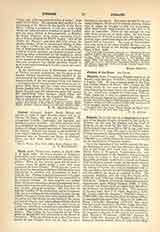

Finland, GRAND DUCHY OF, a department or province of the Russian Empire; bounded on the north by Norway, on the west by Sweden and the Gulf of Bothnia, on the south by the Gulf of Finland. Its limits extend from about 60° to 70° N. lat., and from about 19° to 33° E. long.; the area is 141,617 sq. miles. Finland abounds in lakes and forests, but the proportion of arable soil is small. The population numbers 2,900,000 souls, chiefly Finns; the coasts are inhabited by the descendants of Swedish settlers.
Up to the beginning of the twelfth century the people were pagans; about this date efforts for the conversion of the Finns were made from two sides. The Grand Duke of Novgorod, Vassievolodovich, sent Russian missionaries to the Karelians, Finns living on the Lake of Ladoga in East Finland, while in 1157 King Erik of Sweden undertook a crusade to Finland. Erik established himself firmly on the southwestern coast and from this base extended his power. Henrik, Bishop of Upsala, who had accompanied Erik on this expedition, devoted himself to preaching the Gospel and suffered the death of a martyr in 1158. His successor, Rodulfus, met the same fate about 1178, while the next following bishop, Folkvin, died a natural death. Finlan ained an independent church organization under Bishop Thomas (1220; d. 1248), whose see was Rantemakai; at a later date the episcopal residence was transferred to Abo. The successors of Thomas were: Bero I (d. 1258); Ragvald I (1258-66); Kettil (1266-86); Joannes I (1286-90); Magnus I (1290-1308), who was the first Finn to become bishop; he transferred the see to Abo; Ragvald II (1309-21); Bengt (1321-38); Hemming (1338-66), who made wise laws, built numerous churches, began the collection of a library, and died in the odor of sanctity; in 1514 his bones were taken up, the relics now being in the museum of the city of Abo, but he was not canonized; Henricus Hartmanni (1366-68); Joannes II Petri (1368-70); Joannes II Westfal (1370-85), a bishop of German descent; Bero II (1385-1412); Magnus II Olai Tavast (1412-50), the most important prince of the Church of Finland, who, when eighty-eight years old, undertook arduous visitations; he also went on a pilgrimage to the Holy Land whence he brought back objects of art and manuscripts; Olaus Magni (1450-60), who in earlier years was twice rector of the Sorbonne, a college of the University of Paris, and was also procurator and bursar of the “English nation” at the university. As representative of these he settled the disagreement between Charles VII and the university arising from the part the latter had taken in the burning of Joan of Arc; Conrad I Bitz (1460-89), who in 1488 had the “Missale ecclesiae Aboensis” printed; Magnus III Stjernkors (1489-1500); Laurentius Suurpaa (1500-06); Joannes IV Olavi (1506-10); Arvid Kurck (1510-20), who was drowned in the Baltic; Ericus Svenonis (1523), the chancellor of King Gustavus Vasa; this prelate resigned the see as his election was not confirmed by Rome. He was the last Catholic Bishop of Finland. The king now, on his own authority, appointed his favorite, the Dominican Martin Skytte, as bishop; Skytte did all in his power to promote the violent introduction of Lutheranism. The people were deceived by the retention of Catholic ceremonies; clerics and monks were given the choice of apostasy, expulsion, or death. The only moderation shown was that exhibited towards the Brigittine nunnery of Nadendal. But on the other hand, the Dominicans at Abo and Viborg, and the Franciscans at Kokars were rudely driven out and apparently the inmates of the monastery of Raumo were hung. Then, as later, the Church of Finland did not lack martyrs, among them being Jons Jussoila, Peter Ericius, and others.
By the end of the sixteenth century the Catholic Church of Finland may be said to have ceased to exist. In its place appeared an inflexible and inquisitorial Lutheranism. When in 1617 Karelia (East Finland) fell to Sweden, an effort was made to win the native population, which belonged to the Greek Orthodox Church, for the “pure Gospel”. As this did not succeed, the war of 1566-68 was used for the massacre and expulsion of the people. In consequence of the victories of Peter the Great matters after a while took another course; in 1809 Russia became the ruler of Finland and the Orthodox Greek Church has of late grown in strength. It numbers now 50,000 members under an archbishop; it has fine church buildings, especially in Helsingfors, wealthy monasteries (Valaam and Konevetz), a church paper published at Viborg, and numerous schools. Under Russian sovereignty the long repressed Catholic Church received again (1869 and 1889) the right to exist, but it is still very weak, and numbers only about 1000 souls; there are Catholic churches at Abo and Helsingfors. The great majority of the inhabitants belong now, as before, to the various sects of Protestantism. The State Church of former times, now the “National” Church, to which the larger part of the population adhere, is divided into four dioceses: Abo, Kuopio, Borges, and Nyslott; these contain altogether 45 provostships and 512 parishes. The =Kt of its church building’r”re the domed church of St. Nicholas at Helsingfors and the church at Abo, formerly the Catholic cathedral. Education is provided for by a university and technical high school at Helsingfors, by lyceums of the rank of gymnasia, modern scientific schools, and primary schools. Finland has a rich literature both in Swedish and Finnish. Besides the followers of Christianity there are both Jews and Mohammedans in Finland, but they have no civil rights. Since the middle of the nineteenth century about 200,000 Finns have emigrated to the United States, settling largely in Minnesota and Michigan. The town of Hancock, Michigan, is the center of their religious and educational work.
P. WITMANN

